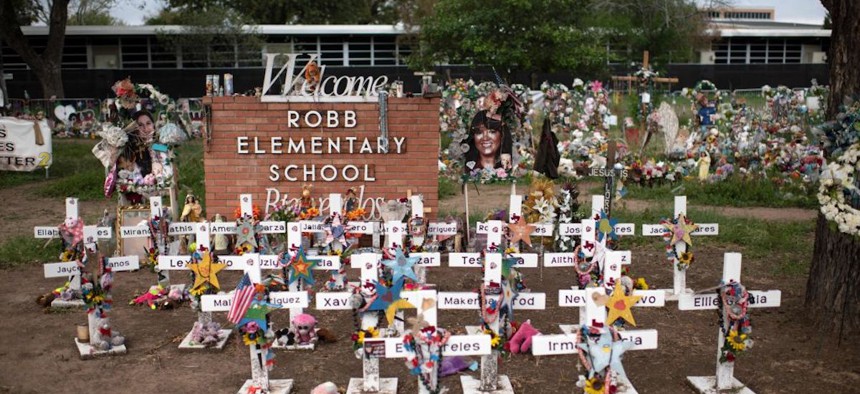Gunfire, screams, carnage: As mass shootings proliferate, training gets more realistic

Crosses set up to honor those who lost their lives during the Robb Elementary School shooting in Uvalde, Texas, on Nov. 8, 2022. MARK FELIX/AFP /AFP via Getty Images
Law enforcement and medical workers experience the sights, smells and sounds of gun violence to prepare for tragedy.
This story is republished from Stateline. Read the original article.
SAN DIEGO, Calif. — The pop-pop-pop of gunfire cracked just as the rain started to fall in grisly synchronicity. Then the screams began.
Within moments, civilians lay strewn across the ground, some lifeless, others writhing in pain. Blood flowed in streams that pooled with the rainwater on the muddying ground littered with shell casings.
Three gunmen quickly opened fire on a San Diego County Sheriff’s Department armored BearCat truck arriving in response. It crawled along an alleyway. Half a dozen SWAT members pointed rifles into open doorways or fired back from behind corners.
One assailant, wearing black gloves and a graying black beard, stood on a third-floor apartment balcony and, as deputies came closer, threw a Molotov cocktail at two white cars parked below. The explosion sent a blast of heat and sound, its boom punctuated by the gunman’s AK-47.
“Help me!” bellowed a man rolling on the ground, blood shooting from his severed leg. Another man groaned next to him, hidden by smoke billowing around the cars.
It seemed like something out of an action movie. And, in a way, it was.
The rounds were blanks, the Molotov cocktail wasn’t lit, the smoke came from a machine. The explosion was controlled, the victims and gunmen were actors, and the blood was fake. However, the deputies, firefighters and doctors from across the region were real.
They were in the middle of a simulation on a Saturday afternoon in mid-January in a commercial lot on the north end of San Diego, conducted by Strategic Operations, a local company run by former Hollywood producers and military combat veterans.
First responders and law enforcement agents have for decades used simulations to train for mass casualty events such as shootings or natural disasters, especially after the Columbine school shooting in 1999. But in recent years, as mass shootings have become increasingly common in the United States, the simulations have become more and more realistic. Now they feature visceral sound effects, trained actors, pyrotechnics and even virtual reality. The trainings also have become more and more expensive for public agencies.
But hyper-realistic simulations are essential for learning how to respond to an active shooter, triage mass casualties and coordinate among departments in a chaotic environment, said Sgt. Colin Hebeler, who works in the Infrastructure Security Group within the San Diego County Sheriff’s Department. The department has two facilities where deputies go through similar simulation training.
“If we can provide these trainings that are as close to the real-life event as possible, you will actually induce that same kind of stress and the reaction that you might have during a real-life incident,” he told Stateline.
Stop the Killing, Stop the Dying
Training has evolved in Hebeler’s 16 years in the department, expanding well beyond both the classroom and limited simulations that involved plastic pieces that looked like guns and shouts of “Bang, bang.” Although expensive, simulated mass shootings are far more intense, realistic and frequent now, he said.
“If it does happen, we’re going to be prepared,” Hebeler added. “We don’t want this to be one of those catastrophic events that comes out on the news, and everyone says, ‘Well, the law enforcement messed up.’”
Law enforcement agencies continue to face public scrutiny over how they respond to mass shooting events — highlighted by last month’s scathing report from the U.S. Department of Justice on the response to the 2022 school shooting in Uvalde, Texas, that left 21 people dead, all but two of them elementary school children.
First responders are trained to focus on two things in a mass shooting event: Stop the killing and stop the dying. By waiting 77 minutes outside the fourth grade classrooms where the active shooter was before confronting and killing him, Uvalde law enforcement failed to follow protocols and that cost lives, the federal report found.
Uvalde showed “layer upon layer upon layer of failures,” said Jaclyn Schildkraut, executive director of the Regional Gun Violence Research Consortium at New York’s Rockefeller Institute of Government. Simulations highlight the sights, sounds and smells of an active shooter event in a controlled environment so the failures seen in Uvalde don’t occur, she said.
“It doesn’t matter if you’re the first officer or by yourself or there’s 20 of you, you go in and you stop the shooter, and then you start trying to help the people who’ve been injured,” she said.
“Simulations are really about acclimating you to what you might encounter on that given day, so that you are able to maintain that focus and subsequently your safety as best as possible.”
But she wanted to be clear about one point: This kind of training should never be used in schools among children. It is far too traumatic.
Simulation’s Increased Use
Seventeen miles east of downtown Raleigh, North Carolina, Wake Technical Community College is building a 60,000-square-foot facility with an 8-acre driving pad that is dedicated to reality-based simulation training for police, fire and emergency medical workers.
From the outside, observers wouldn’t realize the massive gray complex is full of buildings and streets, with spaces designed to mimic the commercial, jail, residential and school spaces first responders would experience in their communities. Trainees can drive into the facility, pull up to a specific location inside and respond to the simulated event — a school shooting, for example, or a fire inside a supermarket.
During mass shooting simulations, trainees will experience the disaster through all their senses: It could smell like smoke, there might be flashing lights and sirens, role players may act as screaming victims or use simulated munitions filled with paint. The $60 million facility, which is slated to open this spring, was funded by a bond that Wake County voters approved in 2018.
For officers, simulation training is much more effective than shooting at a line of paper targets, or simply going over shoot/don’t-shoot scenarios, said Jamie Wicker, provost of public safety education at Wake Tech. Training for mass shooting events has developed over many years with the help of veterans who served in Afghanistan and Iraq, she added.
“It’s one thing to describe chaos. It’s completely different to experience chaos,” said Wicker, who has been in law enforcement for more than 20 years, in part as a trainer. “This is managed chaos.”
This approach has been backed up by researchers who have studied the effectiveness of simulation training for first responders.
One driving factor of that effectiveness is re-creating the high-stress physiological effects, such as an increased heart rate, said Colby Dolly, the director of science and innovation at the National Policing Institute, a Virginia-based research nonprofit.
When officers respond to a mass shooting, they’re running, maybe up a flight of stairs or while carrying people. They will see victims who are injured or dead. They will be worried about the shooter’s location. Meanwhile, parents may be rushing to the scene, along with additional first responders from agencies across the region who might not have interacted with one another before.
While an increased heart rate can produce positive reactions such as adrenaline and sharpened senses, it can quickly turn negative, leading to tunnel vision, auditory exclusion or impaired judgment, Dolly said.
“You want to, at some level, induce that in a training environment,” he said. “It conditions the officer to inoculate them from being overwhelmed by all that when the time comes.”
For the past decade, federal law enforcement has viewed the Advanced Law Enforcement Rapid Response Training Center, known commonly as the ALERRT Center, as the national standard for active shooting simulation training. Hundreds of thousands of police officers have received training from the center, which was formed in the wake of Columbine and has been housed at Texas State University since 2002.
Funded by a line item in the Texas state budget and federal grants, ALERRT is mandated to train 80,000 Texas officers every two years at its facility in San Marcos — a city between Austin and San Antonio. But center experts also go to all 50 states to spread their training, going to schools during breaks and to businesses, at no cost to trainees or their agencies.
Sometimes they use local drama students to play victims, wearing makeup and moulage, simulating a wound. “They love it,” said Larry Balding, external resources director with the center.
First responders take part in a simulation training in San Diego in January. Matt Vasilogambros/Stateline
For the training, ALERRT likes long hallways and T intersections — stress points for law enforcement responding to an active shooter. Beyond learning how to stop the shooter, trainees focus on getting victims to an operating table. Gunshot victims only have around 30 minutes before it’s too late, said Balding, who used to be in the fire service.
“Nobody will ever be 100% ready,” he said. “But if you can get a new officer, get him trained, trying to get the mindset right, that’s what we want to do.”
When asked where simulation training is heading in the field of first responders, Balding didn’t hesitate: virtual reality.
Training in the Virtual World
The floor of the San Diego Convention Center was filled with lifelike mannequins — bleeding, blinking, moving and able to be poked and prodded and to respond to questions. Some were even pregnant, with a baby ready to squirm out when prompted.
Among the 140 health care presenters last month at a conference organized by the Society for Simulation in Healthcare, a membership nonprofit that seeks to promote simulation training to reduce errors in medical care, were companies that want to take the industry in a whole new direction with virtual reality.
Whether first responders use Oculus headsets to learn how to interact with patients in an emergency room or use lifesaving tools at the scene of a shooting, localities are turning more to virtual reality training for first responders, said Dr. Barry Issenberg, president of the society.
“It’s the reduction of errors, safer care, safer way of training,” said Issenberg, who is also the director of the Gordon Center for Simulation and Innovation in Medical Education at the University of Miami. “What we’re doing is not just a cool idea, but ultimately going to make an impact for their constituents.”
The society worked with the Hollywood-style facility, which organized the simulation for the San Diego County Sheriff’s Department and other local first responders who participated the day before. Around 100 visiting academics and health care workers in town for a conference were among the onlookers.
While researchers have found in several studies that virtual reality can add some benefits to health care training, there is still some skepticism.
Dolly, at the National Policing Institute, sees “some promise” with virtual reality for training police officers. It can be a cost-effective alternative to in-person simulations and can help officers train in shoot/don’t-shoot scenarios.
However, he does see limitations with not being able to run around and experience viscerally the confusion of a mass shooting, which can be fully felt with an in-person simulation.
Back at the San Diego shooting simulation, screams still pierced the air.
Gunfire continued for another minute, as the seven deputies dashed from room to room in the complex of buildings. They killed the shooters, then carried some of the wounded down flights of stairs.
After the shots finally stopped, the screams of victims were nearly drowned out by the wail of ambulance sirens.
Firefighters and emergency medical technicians rushed bloodied victims in stretchers to nearby pop-up emergency and operating rooms, where Navy doctors tried to keep their footing on floors slippery with blood and worked to close victims’ wounds.
Wearing blue scrubs and shoe coverings, doctors turned victims on their side and searched for exit wounds. One demanded O negative blood.
An hour after the first shots rang out, the simulation ended. The first responders gathered in the ER in a semicircle. An instructor quieted the room, asked for the beeping heart monitors to be shut off and turned to the participants.
“So, what did we learn?”





